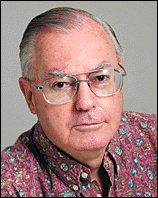


The Rising East
Walking in the land
of the deadThe haunting power of Cambodia's
killing fields still resonates with
the cries of its victimsCheoung Ek, Cambodia >> This killing field is quiet these days, the calm broken only by the hum of swarming dragonflies, the murmuring of a few solemn visitors, and the occasional shout of a child outside the barbed-wire fence.
Even with the silence, however, this is not a serene place. The tall, slender stupa with its glassed-in shelves of human skulls, the simple signs over the mass graves across the pockmarked landscape, the rudimentary diagrams of the extermination center all conjure up horrific visions of the most merciless genocide since the Nazi Holocaust took the lives of 6 million Jews more than a half-century ago.
Between 1975 and 1979, the ultra-leftist Khmer Rouge regime led by Pol Pot and supported by China, murdered 1.5 million to 3 million people -- no one knows exactly how many. Throughout this small Southeast Asian nation, they purged government officials, skilled workers, peasants, business people, diplomats, intellectuals, foreigners, women and children --including babies torn from their mothers' breasts to have their heads bashed in. All told, the Khmer Rouge (Red Khmer) destroyed 20 to 25 percent of the Cambodian population, a people sometimes known by their ancient name, the Khmer.
COURTESY CHRISTOPHER P. HALLORAN
This tall, elegant stupa is lined with neatly stacked skulls -- the heads of Khmer Rouge victims.
The killers were finally stopped by Vietnamese invaders in 1979 but faded into the countryside to continue a guerrilla war until the late 1990s.
Pol Pot died in 1998, but none of the other Khmer Rouge leaders has ever been put on trial, despite an intervention by the United Nations. The Cambodian government appears to have lacked the courage to bring them to justice, although two have been charged recently.
One day under a brutal summer sun a few weeks ago, a young European couple came to stare into the racks of skulls in the stupa, then slipped off to a shady spot where the young woman squatted and broke down, weeping. The reportorial instinct said to go ask who she was and why she wept, but some other instinct said to leave her alone and not to intrude. Was she German, or perhaps Jewish, and the monument to the victims here recalled the death camps at Auschwitz and Dachau?
COURTESY CHRISTOPHER P. HALLORAN
A roof, above, protects a depression in the ground where the headless corpses of 166 victims of the Khmer Rouge are buried. Many of the Khmer Rouge's victims were beheaded or their bodies otherwise too damaged ever to be identified.
Grim as it is, it must be said that the methods of the Khmer Rouge in these killing fields were especially atrocious. They did not shoot their prisoners, so as to save ammunition, but stabbed or beheaded or bludgeoned them to death with shovels or clubs. Many victims died of starvation or from exhaustion in forced labor or lack of basic medical care.
The graves began to be excavated in 1980, but many of the victims could not be identified because of the brutality of their murders. As one sign says: "Mass grave of 166 victims without heads." Dith Pran, a correspondent for The New York Times whose life under the Khmer Rouge was portrayed in the motion picture "The Killing Fields," lost 50 relatives in the slaughter.
Before being sent to Cheoung Ek for execution, the accused of the Khmer Rouge were imprisoned in the capital at Phnom Penh, 10 miles away, in Tuol Sleng, which had been a high school. They were confined to tiny cells with wooden walls built into the classrooms or were shackled by the ankle to an iron bar in the larger rooms. Most slept on the concrete floors with no mats or blankets. The sanitary conditions were unspeakable.
COURTESY CHRISTOPHER P. HALLORAN
A shelf of skulls on display in the stupa.
In Tuol Sleng, the captives were interrogated and tortured, and the women often raped. A sign with security regulations translated into English says, among other things: "You must immediately answer my questions without wasting time to reflect," and "If you disobey any point of my regulations, you shall get either 10 lashes or five shocks of electric discharge."
Each prisoner was photographed for identification. Perhaps the most haunting sights in the prison are the pictures of the children, many too young to understand what was happening to them. They stare out at the visitor with blank, unknowing faces while the adults appear resigned or sullen or even defiant.
Many years ago, A.M. Rosenthal of The New York Times, then a correspondent in Poland, visited Auschwitz. Invoking the memory of the holocaust, he wrote something like: "No one can go to Auschwitz and come away and not write about it."
One might say the same about Cheoung Ek and Tuol Sleng.
Richard Halloran is a former correspondent
for The New York Times in Asia and a former editorial
director of the Star-Bulletin. His column appears Sundays.
He can be reached by e-mail at rhalloran@starbulletin.com